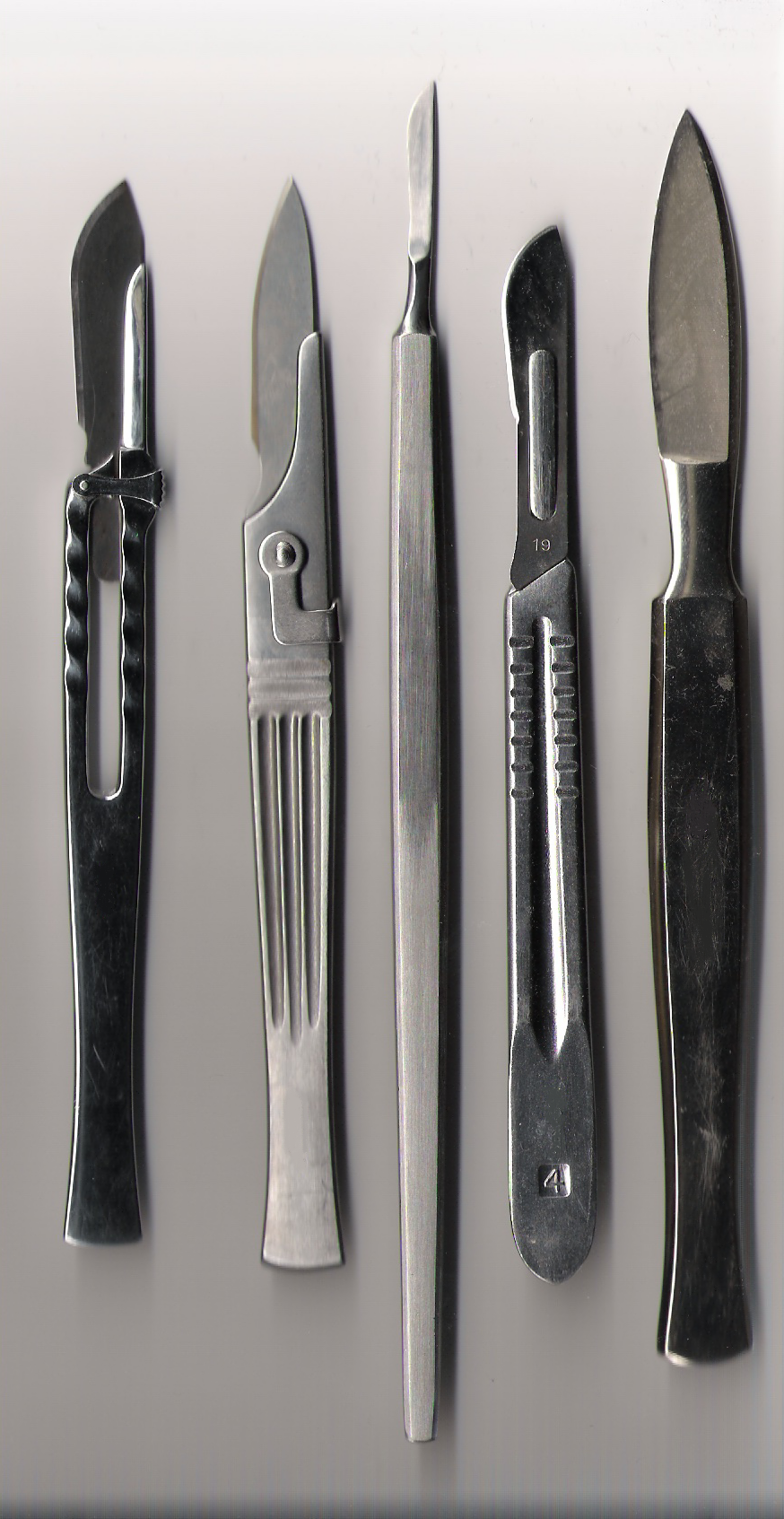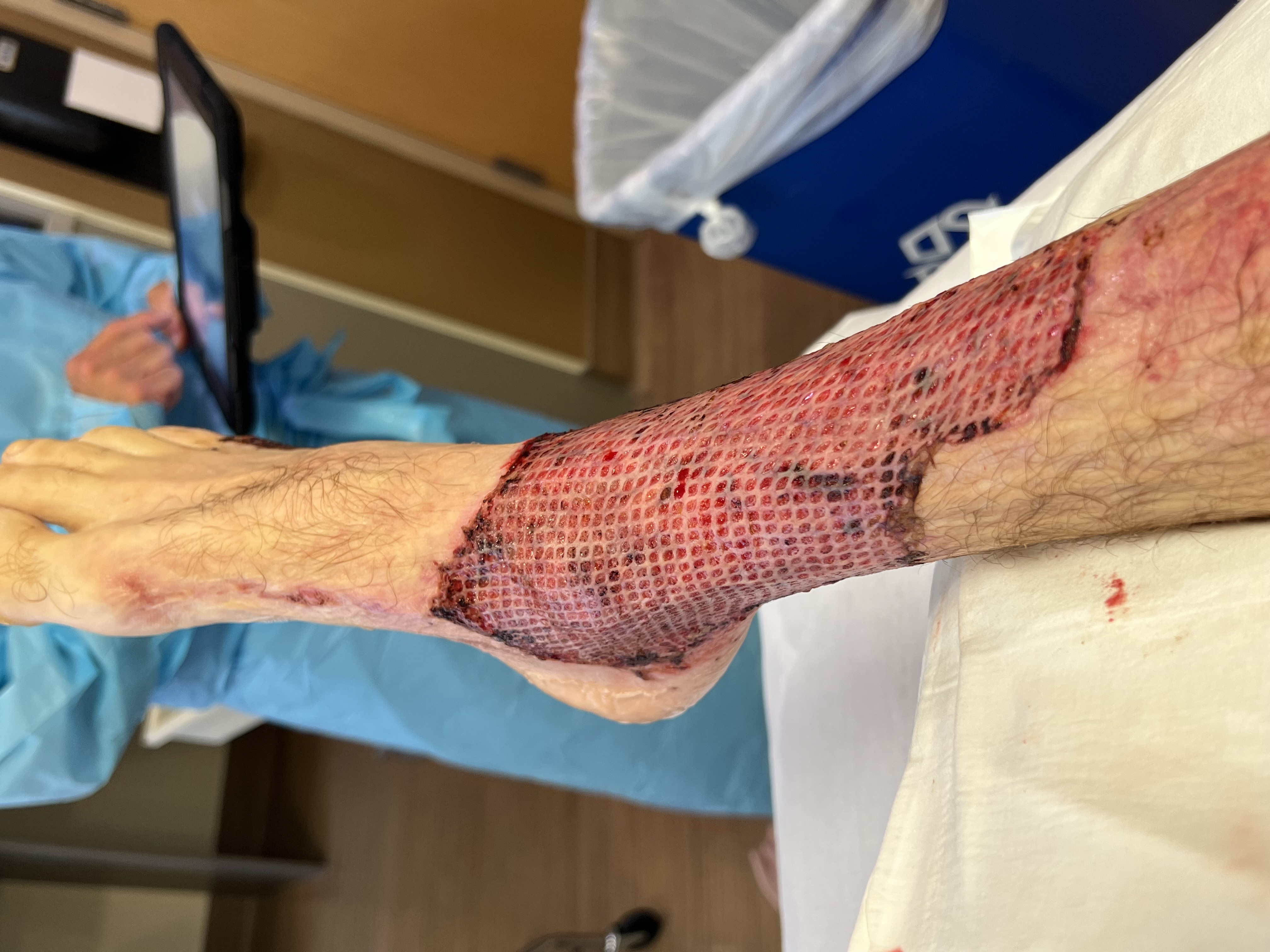|
Dermatome (instrument)
A dermatome is a surgical instrument for producing thin slices of skin from a donor area, for use in skin grafts. One of its main applications is for reconstituting skin areas damaged by grade 3 burns or trauma. Dermatomes can be operated either manually or electrically. The first drum dermatomes, developed in the 1930s, were manually operated. Afterwards, dermatomes which were operated by air pressure, such as the Brown dermatome, achieved higher speed and precision. Electrical dermatomes are better for cutting out thinner and longer strips of skin with a more homogeneous thickness. Free-hand knives Those are manual dermatomes and the term ''knife'' or ''scalpel'' is used to describe them. Their disadvantages are harvesting of grafts with irregular edges and grafts of variable thickness. Their operator has to be experienced in their use for optimal results. Types There are several types of dermatomes, usually named after their inventor. Knives * Blair/Brown knife * Humb ... [...More Info...] [...Related Items...] OR: [Wikipedia] [Google] [Baidu] |
Dermatome
Dermatome may refer to: * Dermatome (anatomy), an area of skin that is supplied by a single pair of dorsal roots * Dermatome (embryology), the portion of the embryonic paraxial mesoderm, the somite, which gives rise to dermis * Dermatome (instrument), a surgical instrument used to produce thin slices of skin {{disambiguation ... [...More Info...] [...Related Items...] OR: [Wikipedia] [Google] [Baidu] |
Surgical Instrument
A surgical instrument is a tool or device for performing specific actions or carrying out desired effects during a surgery or operation, such as modifying biological tissue, or to provide access for viewing it. Over time, many different kinds of surgical instruments and tools have been invented. Some surgical instruments are designed for general use in all sorts of surgeries, while others are designed for only certain specialties or specific procedures. Classification of surgical instruments helps surgeons to understand the functions and purposes of the instruments. With the goal of optimizing surgical results and performing more difficult operations, more instruments continue to be invented in the modern era. History Many different kinds of surgical instruments and tools have been invented and some have been repurposed as medical knowledge and surgical practices have developed. As surgery practice diversified, some tools are advanced for higher accuracy and stability while som ... [...More Info...] [...Related Items...] OR: [Wikipedia] [Google] [Baidu] |
Skin
Skin is the layer of usually soft, flexible outer tissue covering the body of a vertebrate animal, with three main functions: protection, regulation, and sensation. Other animal coverings, such as the arthropod exoskeleton, have different developmental origin, structure and chemical composition. The adjective cutaneous means "of the skin" (from Latin ''cutis'' 'skin'). In mammals, the skin is an organ of the integumentary system made up of multiple layers of ectodermal tissue and guards the underlying muscles, bones, ligaments, and internal organs. Skin of a different nature exists in amphibians, reptiles, and birds. Skin (including cutaneous and subcutaneous tissues) plays crucial roles in formation, structure, and function of extraskeletal apparatus such as horns of bovids (e.g., cattle) and rhinos, cervids' antlers, giraffids' ossicones, armadillos' osteoderm, and os penis/ os clitoris. All mammals have some hair on their skin, even marine mammals like whales, ... [...More Info...] [...Related Items...] OR: [Wikipedia] [Google] [Baidu] |
Skin Graft
Skin grafting, a type of graft surgery, involves the transplantation of skin. The transplanted tissue is called a skin graft. Surgeons may use skin grafting to treat: * extensive wounding or trauma * burns * areas of extensive skin loss due to infection such as necrotizing fasciitis or purpura fulminans * specific surgeries that may require skin grafts for healing to occur - most commonly removal of skin cancers Skin grafting often takes place after serious injuries when some of the body's skin is damaged. Surgical removal (excision or debridement) of the damaged skin is followed by skin grafting. The grafting serves two purposes: reducing the course of treatment needed (and time in the hospital), and improving the function and appearance of the area of the body which receives the skin graft. There are two types of skin grafts: * The more common type involves removing a thin layer of skin from a healthy part of the body (the donor section) - like peeling a potato. * A ful ... [...More Info...] [...Related Items...] OR: [Wikipedia] [Google] [Baidu] |
Burn (injury)
A burn is an injury to skin, or other tissues, caused by heat, cold, electricity, chemicals, friction, or ultraviolet radiation (like sunburn). Most burns are due to heat from hot liquids (called scalding), solids, or fire. Burns occur mainly in the home or the workplace. In the home, risks are associated with domestic kitchens, including stoves, flames, and hot liquids. In the workplace, risks are associated with fire and chemical and electric burns. Alcoholism and smoking are other risk factors. Burns can also occur as a result of self-harm or violence between people (assault). Burns that affect only the superficial skin layers are known as superficial or first-degree burns. They appear red without blisters and pain typically lasts around three days. When the injury extends into some of the underlying skin layer, it is a partial-thickness or second-degree burn. Blisters are frequently present and they are often very painful. Healing can require up to eight weeks and s ... [...More Info...] [...Related Items...] OR: [Wikipedia] [Google] [Baidu] |
Physical Trauma
An injury is any physiological damage to living tissue caused by immediate physical stress. An injury can occur intentionally or unintentionally and may be caused by blunt trauma, penetrating trauma, burning, toxic exposure, asphyxiation, or overexertion. Injuries can occur in any part of the body, and different symptoms are associated with different injuries. Treatment of a major injury is typically carried out by a health professional and varies greatly depending on the nature of the injury. Traffic collisions are the most common cause of accidental injury and injury-related death among humans. Injuries are distinct from chronic conditions, psychological trauma, infections, or medical procedures, though injury can be a contributing factor to any of these. Several major health organizations have established systems for the classification and description of human injuries. Occurrence Injuries may be intentional or unintentional. Intentional injuries may be acts of vio ... [...More Info...] [...Related Items...] OR: [Wikipedia] [Google] [Baidu] |
Dermatome Usage , a surgical instrument used to produce thin slices of skin
{{disambiguation ...
Dermatome may refer to: * Dermatome (anatomy), an area of skin that is supplied by a single pair of dorsal roots * Dermatome (embryology), the portion of the embryonic paraxial mesoderm, the somite, which gives rise to dermis * Dermatome (instrument) A dermatome is a surgical instrument for producing thin slices of skin from a donor area, for use in skin grafts. One of its main applications is for reconstituting skin areas damaged by grade 3 burns or trauma. Dermatomes can be operated eithe ... [...More Info...] [...Related Items...] OR: [Wikipedia] [Google] [Baidu] |
Mucous Membrane
A mucous membrane or mucosa is a membrane that lines various cavities in the body of an organism and covers the surface of internal organs. It consists of one or more layers of epithelial cells overlying a layer of loose connective tissue. It is mostly of endodermal origin and is continuous with the skin at body openings such as the eyes, eyelids, ears, inside the nose, inside the mouth, lips, the genital areas, the urethral opening and the anus. Some mucous membranes secrete mucus, a thick protective fluid. The function of the membrane is to stop pathogens and dirt from entering the body and to prevent bodily tissues from becoming dehydrated. Structure The mucosa is composed of one or more layers of epithelial cells that secrete mucus, and an underlying lamina propria of loose connective tissue. The type of cells and type of mucus secreted vary from organ to organ and each can differ along a given tract. Mucous membranes line the digestive, respiratory and reproductive ... [...More Info...] [...Related Items...] OR: [Wikipedia] [Google] [Baidu] |
Instruments Used In General Surgery
There are many different surgical specialties, some of which require very specific kinds of surgical instruments to perform. General surgery is a specialty focused on the abdominal contents, as well as the thyroid gland, and diseases involving skin, breasts, various soft tissues, trauma, peripheral vascular disease, hernias, and endoscopic procedures. This page is dedicated specifically to listing surgical instruments used in general surgery. Instruments can be classified in many ways - but broadly speaking, there are five kinds of instruments. # Cutting and dissecting instruments: #*Scalpels, scissors, and saws are the most traditional #*Elevators can be both cutting and lifting/retracting #*Although the term dissection is broad, energy devices such as diathermy/cautery are often used as more modern alternatives. # Grasping or holding instruments: #*Classically this included forceps and clamps predominantly #*Roughly, forceps can be divided into traumatic (tissue crushin ... [...More Info...] [...Related Items...] OR: [Wikipedia] [Google] [Baidu] |
Surgical Instruments
A surgical instrument is a tool or device for performing specific actions or carrying out desired effects during a surgery or operation, such as modifying biological tissue, or to provide access for viewing it. Over time, many different kinds of surgical instruments and tools have been invented. Some surgical instruments are designed for general use in all sorts of surgeries, while others are designed for only certain specialties or specific procedures. Classification of surgical instruments helps surgeons to understand the functions and purposes of the instruments. With the goal of optimizing surgical results and performing more difficult operations, more instruments continue to be invented in the modern era. History Many different kinds of surgical instruments and tools have been invented and some have been repurposed as medical knowledge and surgical practices have developed. As surgery practice diversified, some tools are advanced for higher accuracy and stability while so ... [...More Info...] [...Related Items...] OR: [Wikipedia] [Google] [Baidu] |
Plastic Surgery
Plastic surgery is a surgical specialty involving the restoration, reconstruction or alteration of the human body. It can be divided into two main categories: reconstructive surgery and cosmetic surgery. Reconstructive surgery includes craniofacial surgery, hand surgery, microsurgery, and the treatment of burns. While reconstructive surgery aims to reconstruct a part of the body or improve its functioning, cosmetic (or aesthetic) surgery aims at improving the appearance of it. Etymology The word ''plastic'' in ''plastic surgery'' means "reshaping" and comes from the Greek πλαστική (τέχνη), ''plastikē'' (''tekhnē''), "the art of modelling" of malleable flesh. This meaning in English is seen as early as 1598. The surgical definition of "plastic" first appeared in 1839, preceding the modern "engineering material made from petroleum" sense by 70 years. History Treatments for the plastic repair of a broken nose are first mentioned in the Egyptian medical ... [...More Info...] [...Related Items...] OR: [Wikipedia] [Google] [Baidu] |





